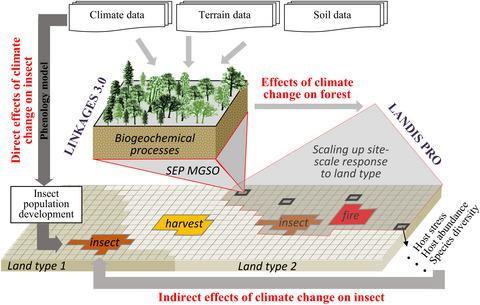当前位置:
X-MOL 学术
›
J. Appl. Ecol.
›
论文详情
Our official English website, www.x-mol.net, welcomes your feedback! (Note: you will need to create a separate account there.)
Indirect effects mediate direct effects of climate warming on insect disturbance regimes of temperate broadleaf forests in the central U.S.
Journal of Applied Ecology ( IF 5.7 ) Pub Date : 2021-08-10 , DOI: 10.1111/1365-2664.13987 Shengwu Duan 1 , Hong S. He 1 , Martin A. Spetich 2 , Wen J. Wang 3 , Jacob S. Fraser 4 , Frank R. Thompson 4
中文翻译:

间接影响介导气候变暖对美国中部温带阔叶林昆虫干扰机制的直接影响
更新日期:2021-08-10
Journal of Applied Ecology ( IF 5.7 ) Pub Date : 2021-08-10 , DOI: 10.1111/1365-2664.13987 Shengwu Duan 1 , Hong S. He 1 , Martin A. Spetich 2 , Wen J. Wang 3 , Jacob S. Fraser 4 , Frank R. Thompson 4
Affiliation

|
- Climate warming directly affects insect disturbance regimes by altering temperature-dependent population development. Indirect effects of climate change on insect disturbance may mediate or accelerate direct effects via vegetation feedback (e.g. host tree demographic dynamics). However, such indirect effects have rarely been incorporated in predicting insect disturbance regimes.
- We included both direct and indirect effects in a forest landscape modelling framework to simulate red oak borer [ROB, Enaphalodes rufulus (Coleoptera: Cerambycidae)] disturbance regimes under a warming climate from 2000 to 2150 in the Central Hardwood Forests, U.S. We quantified effect sizes and relative importance of direct effects and indirect effects of warming climate on the ROB disturbance using a factorial experimental design and two-way ANOVA.
- Both direct and indirect effects acted positively in the short and medium term (e.g. 0–100 years) while the effect size of indirect effects changed over time from positive (+30.9 kha) to negative (−17.3 kha) and mediated the positive direct effects in the long term (e.g. 100–150 years).
- Direct effects had greater influence than indirect effects on ROB disturbed areas in the short term (e.g. <50 years), whereas indirect effects were more important (ω2 = 0.38 vs. 0.26) in the long term. This was because the host tree abundance significantly declined over time under warming climates, which decreased the forest susceptibility to ROB and thus overrode the outbreak-promoting effects of warming climates in the long term.
- Synthesis and applications. This study reveals indirect effects of warming climates mediate direct effects on insect disturbance regimes by altering primary host tree demographic dynamics. We highlight that indirect effects are important in understanding insect disturbance regimes under warming climates as they may mediate or even reverse the expectation of increased insect disturbance. Long-term predictions of insect disturbance without considering indirect effects may overestimate its impacts under warming climates. Our findings also indicate that different management interventions are required at different time-scales to maintain oak forests' health and sustainability in the U.S. central temperate broadleaf forests.
中文翻译:

间接影响介导气候变暖对美国中部温带阔叶林昆虫干扰机制的直接影响
- 气候变暖通过改变依赖温度的种群发展直接影响昆虫干扰机制。气候变化对昆虫干扰的间接影响可能会通过植被反馈(例如寄主树木的人口动态)介导或加速直接影响。然而,这种间接影响很少被纳入预测昆虫干扰状况。
- 我们在森林景观建模框架中包括了直接和间接影响,以模拟2000 年至 2150 年美国中部阔叶林在变暖气候下红橡木螟 [ROB, Enaphalodes rufulus (Coleoptera: Cerambycidae )] 的干扰机制,我们量化了影响大小以及使用因子实验设计和双向方差分析的气候变暖对 ROB 干扰的直接影响和间接影响的相对重要性。
- 直接和间接影响在短期和中期(例如 0-100 年)都起到积极作用,而间接影响的影响大小随时间从积极(+30.9 kha)变为消极(-17.3 kha)并调节了积极的直接影响长期(例如 100-150 年)。
- 在短期内(例如<50 年),直接影响比间接影响对ROB 干扰区域的影响更大,而从长期来看,间接影响更重要(ω 2 = 0.38 vs. 0.26)。这是因为在气候变暖的情况下,寄主树的丰度随着时间的推移而显着下降,这降低了森林对 ROB 的易感性,从而从长远来看超过了气候变暖的爆发促进效应。
- 合成与应用。这项研究揭示了气候变暖的间接影响通过改变主要寄主树木的人口动态来调节对昆虫干扰制度的直接影响。我们强调间接影响对于理解气候变暖下的昆虫干扰机制很重要,因为它们可能会介导甚至逆转昆虫干扰增加的预期。在不考虑间接影响的情况下对昆虫干扰的长期预测可能会高估其在气候变暖下的影响。我们的研究结果还表明,需要在不同的时间尺度上采取不同的管理干预措施来维持美国中部温带阔叶林橡树林的健康和可持续性。


























 京公网安备 11010802027423号
京公网安备 11010802027423号